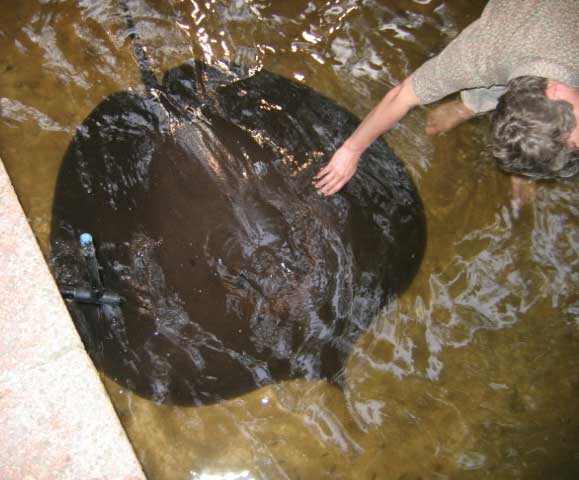Himantura chaophraya (*) Cladus: Eukaryota Vernacular names ------- The giant freshwater stingray, Himantura chaophraya, is a species of stingray in the family Dasyatidae, native to large rivers and estuaries of Southeast Asia.[2] It is one of the largest freshwater fishes in the world, with reports from the Chao Phraya and Mekong Rivers of individuals weighing 500-600 kg (1,100-1,300 lbs).[3] Its numbers are dwindling due to overfishing and habitat loss, and some local populations are in danger of going extinct.[1] The smaller freshwater whipray of New Guinea and northern Australia was once considered to be conspecific with the giant freshwater stingray but is now recognised as a separate species. Originally described from Thailand (where it occurs in the Chao Phraya, Nan, Mekong, Bongpakong, Tachin and Tapi Rivers), the giant freshwater stingray is also found in Indonesia (the Mahakam River Basin in Kalimantan) and Malaysia (the Kinabatangan River in Sabah). The rays across these different regions are likely to be isolated from each other, and it is yet unclear whether they represent populations of the same species or a species complex.[4] It prefers a sandy habitat.[2] Description The giant freshwater stingray has a relatively thin, more or less oval-shaped pectoral fin disk and minute eyes. The snout is very broad with a projecting triangular tip. The mouth is small, with 4-7 papillae (2-4 large central and 1-4 small lateral) on the floor. The whip-like tail measures 1.8-2.5 times the length of the disk and lacks fin folds.[4] The serrated spine on the tail is the largest of any stingray, reaching 38 cm (15 in) long. It is covered with a sheath of toxic mucus and is capable of piercing bone.[5] The upper surface of the body and tail are covered with small, rough tubercles, becoming sharp on the tail beyond the spine. The back is uniform brown to gray in color, sometimes becoming lighter towards the margins. The underside is white, with a distinctive broad, black band edged with small spots around the margins of the pectoral and pelvic fins.[3] The tail is black past the spine. This species reaches at least 4.6 meters (15 ft) long and 1.9 meters (6.2 ft) across..[4] Biology and ecology The diet of this species consists of benthic fishes and invertebrates, which it detects using electroreceptive ampullae of Lorenzini.[2] As in other stingrays, reproduction is ovoviviparous, with females giving birth to one offspring at a time.[6] A 4.3 meter (14 ft) captured female has been observed giving birth to a single newborn measuring 34 cm (13 in) across.[7] Males mature at 1.1 meters (3.6 ft) across.[4] Relationship to humans This species is threatened by overfishing and habitat loss; the World Conservation Union has assessed the giant freshwater stingray as Vulnerable over its entire range.[1] It is occasionally caught as bycatch by longlines and gillnets in central Thailand and likely elsewhere. This species is sold for meat and possibly cartilage; adult fish are not usually used for food but may still be killed or maimed by fishers. [6] There is a growing sport fishery for this species. When caught on a line, it may bury itself under large quantities of mud, making it almost impossible to lift. It is also capable of pulling boats significant distances or underwater.[5] In Thailand, the freshwater stingray is assessed as Critically Endangered with a high risk of extinction.[8] A combination of deforestation, dam construction, and development has degraded, altered, and fragmented river habitats such as that only a fraction of Thailand's native fish species still breed in the wild. In the 1990s, the Thai government initiated a captive breeding program to bolster the population of this and other freshwater stingray species until the habitat degradation can be remedied. However, the program was later put "on hold".[6] References 1. ^ a b c Shark Specialist Group (2000). Himantura chaophraya. In: IUCN 2000. IUCN Red List of Threatened Species. Downloaded on March 24, 2009.
Source: Wikispecies, Wikipedia: All text is available under the terms of the GNU Free Documentation License |
|

